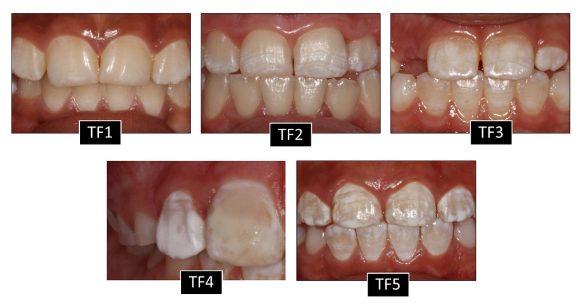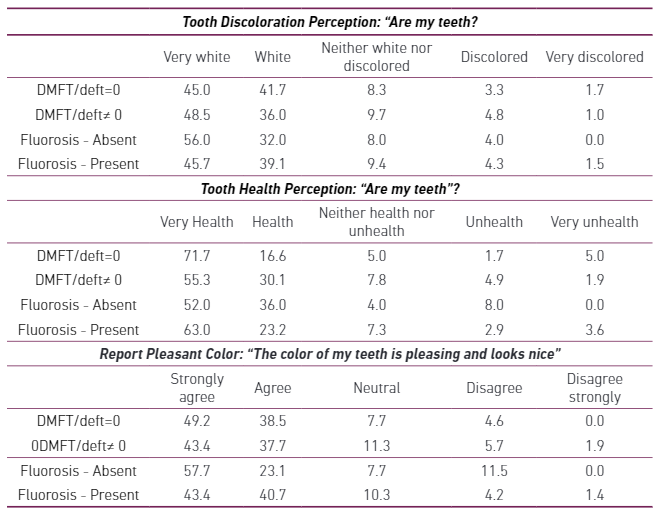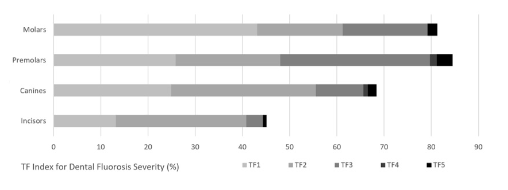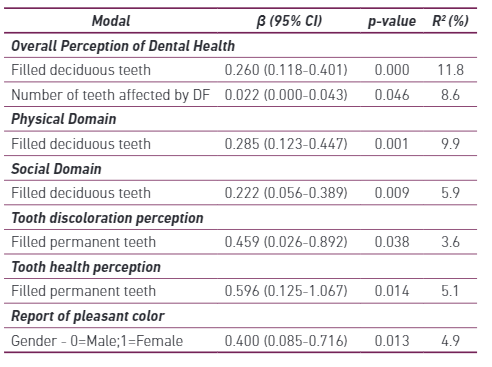Introduction
Dental caries is a serious public health problem worldwide. The use of fluoride for the prevention of dental caries is supported by scientific evidence. The addition of this chemical to water or to salt is cost-effective, and is frequently part of public oral health programs 1).
However, excessive intake of fluoride can cause acute or chronic intoxication. Dental enamel fluorosis (DF) is the most widely studied side effect attributed to prolonged and excessive fluoride intake, and occurs during tooth development 2. DF affects the deciduous and permanent dentition, and can vary from diffuse white lines to structural alterations 3. Severe cases compromise the dental surface and increase the susceptibility to dental caries. (4. Global DF prevalence is about 12.9% (95% CI 7.5-18.3%), according to 57 studies included in a meta-analysis study 5, and it has been reported to range from 30% to 81% in Colombia 6-8.
DF aesthetic changes can impact affected individuals psychologically. Although the impact of DF on aesthetic perceptions has been demonstrated in some studies (9-11), other studies have not established this association 12. There also exists some discussion about how socioeconomic status may affect perceptions, since individuals belonging to populations with a lower socioeconomic status were reported in the past to have lower aesthetic concerns 13. Therefore, the objective of the present study was to evaluate the impact of DF on aesthetic perceptions in a low-income community with high DF prevalence.
Materials and methods
This cross-sectional study was approved by the Ethics Committee on Human Research of CES University, Medellin, Colombia, protocol number 254, and all participants signed the informed consent after receiving an explanation of the research objectives and procedures.
Sample Selection
The sample size of this study was 171 Colombia schoolchildren aged 8 to 12 years, born in the El Cedro, district of Ayapel, Córdoba. This district is located in northern Colombia, and has 946 residents. All schoolchildren aged 8 to 12 years was included in the study. It is a riverside population, and the closest city is 10 minutes away by boat, on the San Jorge River. Its population receives healthcare provided by the CES University medical and dental students.
Measuring Instruments
The Spanish version of the “Child Perceptions Questionnaire About Tooth Appearance” (CQATA) (14) with five questions was applied to all participants. The CQATA was used to measure the children’s aesthetic perceptions about their teeth. This instrument includes issues regarding physical, psychological and social domains, as well as perceptions of color change and other aesthetic conditions. It provides multiple-choice answers to items and sub-items 14).
The first three items cover issues that were observed in the previous two months regarding feeling uncomfortable (physical domain), worrying (psychological domain) and having smiling constraints (social domain), because of tooth appearance. The overall perception of dental health represented the total score of the physical, psychological and social domains. The fourth item assesses the perception about tooth pleasantness, alignment, discoloration and health. In addition, the report of pleasant color domain asks the respondents how satisfied they are with the color of their teeth.
Data Collection
All the schoolchildren were clinically evaluated by two examiners previously trained and calibrated for caries detection in permanent and deciduous teeth, according to the DMFT and the deft indexes, following the WHO criteria 15, and in fluorosis detection according to the TF index (kappa intraexaminer>0.89 and interexaminer>0.87). The criteria developed by Thylstrup and Fejerskov in 1978 was used, whereby a score is assigned to the vestibular surface of each tooth 3.
Examinations were performed in dental chairs with dental lights, and standard infection control measures for epidemiological studies were followed. The CQATA questionnaire was applied before the clinical exam, under the supervision of researchers.
Statistical Analysis
The data collected were evaluated statistically using SPSS 22. The statistical analyses were divided according to gender, age, DMFT/deft≠0, DF presence and DF severity in anterior teeth. The means of the CQATA scores for each domain were computed. The missed values were inputted by means for each domain and for each person 16.
After applying the Kolmogorov-Smirnov test for normality, the Student´s t-test was used to evaluate differences in CQATA for gender, DMFT/deft≠0 and DF presence. The one-way ANOVA test was used to assess differences in the CQATA by age and DF severity in anterior teeth.
Linear regressions were used for each question on the questionnaire, and for the other 16 variables: gender, age, decayed permanent, decayed deciduous, missed permanent, missed deciduous, filled permanent, filled deciduous, DMFT, deft, DMFT or deft≠0, DF presence, DF severity, DF anterior teeth severity, number of affected teeth and number of affected anterior teeth. The effective variables were entered in the model at p = 0.05 using regression analysis.
Results
In all, 171 students, 8 to 12 years old, were included in this study; 55.6% were female. The prevalence of DF in this sample was 84.8% (n=145), with a higher prevalence found in males. DF severity ranged between TF1 and TF5 (Figure 1). Of the 2091 affected teeth, 38.6% (807) presented the score of TF1, 36.8% (770) had a score of TF2, 21.1% (444) were TF3, 0.5% (22) were TF4, and 2.8 % (58) were TF5 (Figure 2).

Figure 1 TF1: 12, 11, 21 and 22 teeth with fine white lines crossing the tooth surface. TF2: 12, 11, 21 and 22 teeth with more pronounced white and opaque lines that often fuse to form wider bands. TF3: 11 and 21 teeth with all dental surfaces show opaque white and cloudy areas. TF4: 12 teeth with every surface exhibit marked opacity. TF5: 12, 11 and 22 teeth with all surfaces opaque and depressions less than 2mm in diameter.
Caries prevalence was 62%. The DMFT index was 0.62, and the deft index was 1.37. No association was found between DF and dental caries. Tables 1 and 2 present answers to the questions of the CQATA, according to demographic caries experience and dental fluorosis presence. Only the presence of caries (DMFT/deft≠0) had significant impact on aesthetic perceptions (Student´s t-test) in physical domain (p=0.010) and tooth health perception (p=0.008).
Table 1 Frequency (%) of CQATA domains: physical, psychological and social domains, according to caries experience and dental fluorosis presence

Table 2 Frequency (%) of CQATA domains: tooth discoloration perception, tooth health perception and report pleasant color domain, according to caries experience and dental fluorosis presence

Table 3 presents the results of the linear regression used to assess the correlation between means and another 16 factors related with the child oral health status. The results show that filled teeth had a significant positive correlation with mean overall perception of dental health, physical domain, social domain, tooth discoloration perception and tooth health perception. Girls showed an increase of 4.9% over the average rate, in relation to the boys in the report of pleasant color domain. The number of teeth affected by DF had a significant positive correlation with mean overall perception of dental health.
Discussion
The perception of what is aesthetically acceptable is subjective and influenced by cultural, socioeconomic, psychological and physical factors, and may change over time 13. Not only clinical features, but also psychosocial aspects must be considered in determining to what extent DF impacts a population.
The community studied in the present study had an overall low socioeconomic level and a high prevalence of fluorosis (84.8%), the highest reported in Colombia. In 2009, Ramírez-Puerta et al. brought attention to a growing increase in the DF indexes in the country 6. A high prevalence of fluorosis was also found in the Colombian cities of Bucaramanga 17, Bogotá 18, Frontino 19, Andes 20, Sagamoso 21 and Caldas 7.
This article does not aim to discuss what source of fluoride is used in Colombia; nonetheless, it is noteworthy to mention, in connection with the high prevalence of dental fluorosis, that Colombia uses salt fluoridation 22, and the fluoride concentration has been reported to be within the current recommended standards 23. There are also studies that have investigated rocks, soil and water as potential sources of fluoride in endemic regions 23; however, the potential sources of excessive fluoride intake remain to be identified.
Despite the high prevalence of DF observed in this study, it does not seem to be severe. The most prevalent severity was the mildest (TF1 and TF2), and was found in 75.4% of the affected teeth. These values corroborate the results of other studies conducted in Colombia, which have also evaluated DF severity (6, 7). This high prevalence also seems to have only minimally impacted the overall perception of the dental health domain, with an average increase of 0.022 for each tooth affected by DF. In addition, there was no association between the DF and the report of pleasant color domain.
Similar studies show that children with DF are not very concerned about their condition. This suggests that their perception of having fluorosis does not necessarily mean that they are dissatisfied or concerned about the appearance of their teeth 12. On the other hand, studies that included adolescents with DF reported that they perceive it as an aesthetic problem 9. When the DF was of greater severity, a greater impact was perceived 10. In contrast, other studies on adolescents have reported that even cases with mild DF led to feeling ashamed, to such an extent that it kept participants from smiling (11, 24). These results may indicate that a change in perception may occur during adolescence.
In this study, there was an impact on the perception of tooth discoloration and health by children whose DMFT/deft was not zero, often influenced by the number of restored teeth. However, dental caries was not associated with the report of pleasant color.
A significantly lower satisfaction with the color of one’s teeth was found in regard to gender, in that the girls showed the worst results. These findings corroborate those of other studies with psychosocial variables, where female patients tended to present worse values than male patients 25,26.
There was a high prevalence of DF in this low socioeconomic population, but DF was frequently mild, without impacting the report of pleasant color domain. Nonetheless, the changes in aesthetic impact across time should be investigated, especially in girls and as perceived by them at different ages.
















